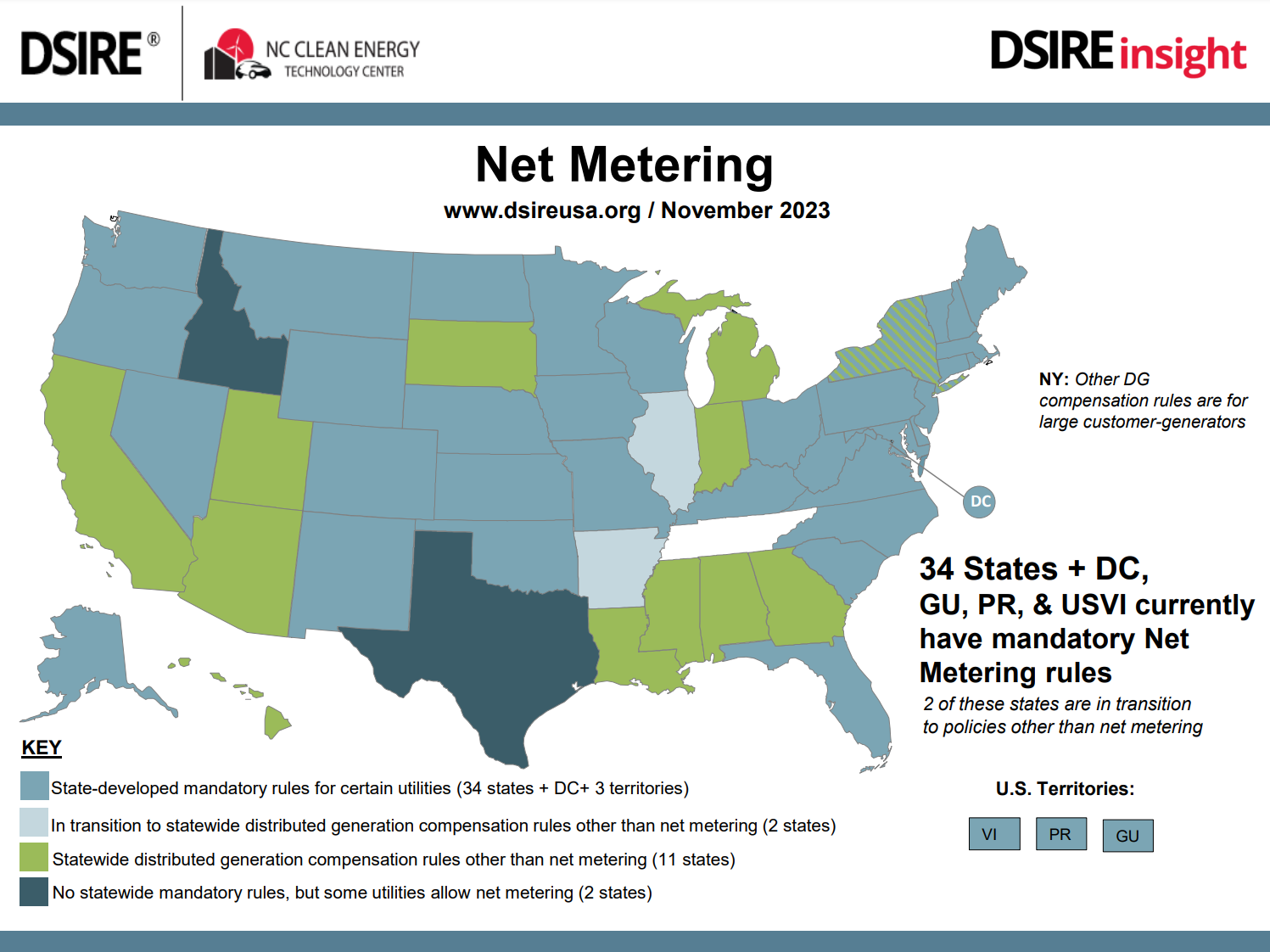Net Metering
Net metering allows residential and commercial customers who generate their own electricity from solar power to sell the electricity they aren't using back into the grid. Many states have passed net metering laws. In other states, utilities may offer net metering programs voluntarily or as a result of regulatory decisions. Differences between state legislation, regulatory decisions and implementation policies mean that the mechanism for compensating solar customers varies widely across the country
What Is Net Metering?
Net metering is a billing mechanism that credits solar energy system owners for the electricity they add to the grid. For example, if a residential customer has a PV system on their roof, it may generate more electricity than the home uses during daylight hours. If the home is net-metered, the electricity meter will run backwards to provide a credit against what electricity is consumed at night or other periods when the home's electricity use exceeds the system's output. Customers are only billed for their "net" energy use. On average, only 20-40% of a solar energy system’s output ever goes into the grid, and this exported solar electricity serves nearby customers’ loads.
Giving Customers Control Over Their Electricity Bills
Net metering allows utility customers to generate their own electricity cleanly and efficiently. During the day, most solar customers produce more electricity than they consume; net metering allows them to export that power to the grid and reduce their future electric bills.
Creating Jobs & Encouraging Private Investment
Net metering provides substantial economic benefits in terms of jobs, income and investment. Net metering increases demand for solar energy, which in turn creates jobs for the installers, electricians, and manufacturers who work in the solar supply chain. Today, the solar industry employs more than 230,000 American workers in large part due to strong state net metering policies which have allowed the solar industry to thrive.
Protecting the Electric Grid
Unfortunately, some utilities perceive net metering policies as lost revenue opportunities. In fact, net metering policies create a smoother demand curve for electricity and allow utilities to better manage their peak electricity loads. By encouraging generation near the point of consumption, net metering also reduces the strain on distribution systems and prevents losses in long-distance electricity transmission and distribution. There are a wide variety of cost-benefit studies around the country that demonstrate the value solar provides to local economies and the electricity system as a whole.
Want to support net metering policies in your state? Advocate for solar energy. Your voice counts!
Want to learn more about how net metering policies work with solar? Learn more about net metering and other solar topics on EnergySage.
Click on the map below to visit the Database of State Incentives for Renewable Energy (DSIRE), which catalogues various policies for renewable energy nationwide, including net metering. 34 states plus Washington, D.C. and Puerto Rico have mandatory net metering rules in place.

Principles for the Evolution of Net Metering and Rate Design
SEIA worked with a broad array of stakeholders to develop a set of principles to guide the future of net metering and rate design.
Related News
United States Surpasses 2 Million Solar Installations
The U.S. is now home to more than 2 million solar PV installations, Wood Mackenzie Power & Renewables and the Solar Energy Industries Association (SEIA) announced today.
SEIA Commends Texas Senate for Passing Bill to Protect Solar Consumers
WASHINGTON, D.C. - Following is a statement from Katherine Gensler, vice president of regulatory affairs for the Solar Energy Industries Association, on the passage of S.B. 2066 in the Texas Senate:
New York PSC Makes Needed Improvements to the Value of Distributed Energy Resources Framework
"Community Credit" will help expand access to community solar for more New Yorkers
Related News
Leading the Charge: The Top 5 Solar States of 2023
Solar is coming off a landmark, record-shattering year in 2023. To celebrate this momentous year, SEIA is counting down the top five solar states of 2023 — all of which are positioning themselves as national leaders in America’s energy economy.
Solar Installations Skyrocket in 2023 in Record-Setting First Full Year of Inflation Reduction Act
WASHINGTON, D.C. — The U.S. solar industry added a record-shattering 32.4 gigawatts (GW) of new electric generating capacity in 2023, a 37% increase from the previous record set in 2021 and a 51% increase from 2022. According to the U.S. Solar Market Insight 2023 Year-in-Review released today by the Solar Energy Industries Association (SEIA) and Wood Mackenzie, solar accounts for 53% of all new electric generating capacity added to the grid last year.
Raising the Bar for Consumer Protection Work in the Solar and Storage Industry
Solar remains one of the most popular energy sources across America, and millions of Americans have already made the switch to solar. This surge in demand means even more Americans will consider solar or solar plus storage for the first time in the near future, making this the right time to double down on consumer protection.
